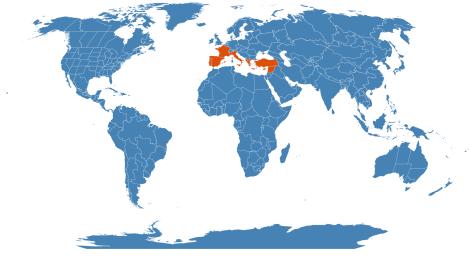Accession Data
Pinus pinea
Common Name: Italian Stone Pine
Family: Pinaceae
Country of Origin: S. Europe to Lebanon
Description: A tree 12-25(35) m tall, trunk often short and commonly slightly sinuous. Crown highly distinctive (shape shared only by P. nelsonii of NE Mexico), globose and shrubby when young, later domed and becoming very broad low-rounded with age; not conic except in first two years from seed; with long branches rising at 30°-60° above horizontal; branch tips upswept to vertical. Bark thick, plated, deeply fissured, red-brown to orange with blackish edges to the plates. Shoots usually uninodal, very rarely multinodal on vigorous young trees; moderately stout, yellow-buff, rough with persistent decurrent scale-leaf bases. Buds ovoid-acute, 7-20 mm, with red-brown scales with long free tips revolute and fringed with white hairs. Adult leaves mid-green, retained for 2-4 years, with a persistent 1-1.5 cm sheath, in fascicles of two, 10-18(28) cm long, about 1.5 mm thick, with serrulate margins and fine lines of stomata on both faces. The juvenile leaves are glaucous, 1.5-4cm long, and continue to be grown for 3-10 years, mixed with the first adult leaves from the third year. Cones on short stout stalks, symmetrical, broad ovoid to globose, 8-12(15) cm long, 5-11(12) cm broad when closed, resembling a children's comic idea of a hand-grenade (!); green, ripening shiny chestnut-brown in April three years after pollination (the longest maturation period of any pine). The scales are broad, thick, woody, very stiff; the apophysis is bulbous, 15-20 × 15-20 mm, smoothly rounded; due to the three-year maturation, the dorsal grey-buff umbo is double, with an inner umbo (first year's growth) and a concentric outer umbo (second year); the inner umbo has a very short stout reflexed mucro. The seeds are pale brown thickly covered with a black soot-like powder, 15-20 × 10 mm with a loosely attached vestigial 3-8 mm yellow-buff wing. The cones open on ripening or up to a year later, invariably shedding all the infertile basal scales to allow the fertile scales to open more widely; the large seeds are dispersed by birds, mainly Cyanopica cyanus (azure-winged magpie), and in the last 6,000+ years, by humans, which has considerably extended the pine's distribution.4
Accession Data
Accession #: 201900002
Accession Date: 2018-12-31 00:00:00
Bloom Status: 🪴 Not Flowering
Location: 2104
Quantity: 1
Source: John Korte ex RocketFarms.com
Classification
Division: Pinophyta
Class: Pinopsida
Subclass: Pinidae
Order: Pinales
Family: Pinaceae
SubFamily: Pinoideae
Flowering Data:
This accession has been observed in bloom on:| Year | Jan | Feb | Mar | Apr | May | Jun | Jul | Aug | Sep | Oct | Nov | Dec | ||||||||||||||||||||||||||||||||||||||||
|---|---|---|---|---|---|---|---|---|---|---|---|---|---|---|---|---|---|---|---|---|---|---|---|---|---|---|---|---|---|---|---|---|---|---|---|---|---|---|---|---|---|---|---|---|---|---|---|---|---|---|---|---|
| 2025 | ||||||||||||||||||||||||||||||||||||||||||||||||||||
| 2024 | ||||||||||||||||||||||||||||||||||||||||||||||||||||
| 2023 | ||||||||||||||||||||||||||||||||||||||||||||||||||||
| 2022 | ||||||||||||||||||||||||||||||||||||||||||||||||||||
References
- The Plant List (2013). Version 1.1. Last accessed on Monday, 31 December, 2018.
- WCSP (2015). World Checklist of Selected Plant Families. Facilitated by the Royal Botanic Gardens, Kew. Last accessed on Monday, 31 December, 2018.
- Pinus pinea at WikiSpecies. Last accessed on Monday, 31 December, 2018.
- Pinus pinea at The Gymnosperm Database. Last accessed on Monday, 31 December, 2018.
Images

